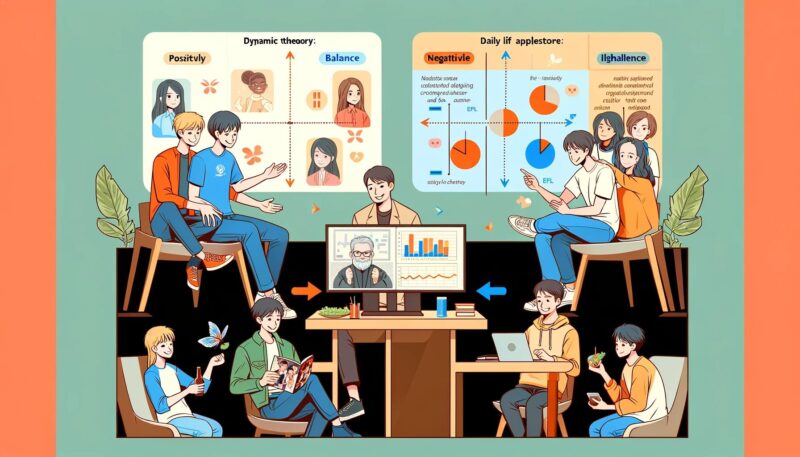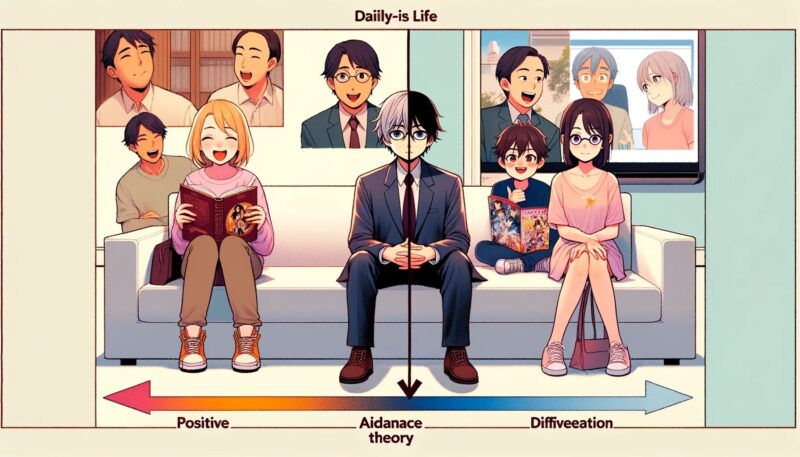この記事を読もうとしている皆さんは
- バランス理論とは?
- バランス理論の具体例は?
このような疑問や不安を抱えていませんか?
今回は、そのような疑問や不安を抱えている方に向けて
- バランス理論の概要
- 私の経験に基づく具体例
これらについて分かりやすく解説します。
ぜひ、本記事を参考に、バランス理論の理解を深めていきましょう。
バランス理論とは?

バランス理論は、社会心理学者のフリッツ・ハイダーによって提唱された理論で、個人の認知的なバランスの維持に関する概念です。
この理論は、特に人間関係や態度の整合性に焦点を当てています。
理論の概要
バランス理論は、三者関係(P-O-X)の中で説明されます。
ここでPは人物(Person)、Oは他の人物(Other)、Xは対象(Object)を表します。
この三者関係がバランスを保つためには、以下の条件が必要です。
- すべての関係が正の関係(PがOを好み、OがXを好み、PもXを好む)。
- 二つの正の関係と一つの負の関係(例えば、PがOを好み、OがXを好むが、PがXを嫌う)。
これらの条件が満たされない場合、バランスが崩れ、個人は心理的な緊張を感じ、それを解消するために態度や関係を変更しようとします。
理論の応用例
バランス理論は、以下のような状況で適用されます。
人間関係
例えば、友人Aが友人Bを好んでいるが、友人Cを嫌っているとします。
この時、友人Bが友人Cを好きか嫌いかによって、友人Aの態度や関係が影響を受ける可能性があります。
マーケティング
消費者があるブランド(X)を好んでいる場合、そのブランドを支持している有名人(O)も消費者(P)から好意的に見られる傾向があります。
理論の限界
バランス理論にはいくつかの限界があります。
例えば、実際の人間関係や態度は必ずしも三者関係だけに限定されるわけではなく、複雑な要因が絡み合うことが多いです。
また、個人の認知的なバランスの維持には、他の心理的理論や要素も影響を与えることがあります。
バランス理論の具体例は?

日常生活での適用例
毎日の生活の中で、私はバランス理論を様々な場面で感じ、適用しています。
特に友人関係や学業、趣味のアニメ観賞において、この理論は重要な役割を果たしています。
友人関係
例えば、私の友人AとBの関係において、私が感じるバランスの重要性についてです。
友人AとBが仲良くしていると、私もその関係にポジティブな感情を持ちます。
しかし、もし友人Aが新たに知り合った友人Cとトラブルを抱えていた場合、私のAに対する感情やCとの関係にも影響が出ます。
この時、バランス理論の観点から私はCとの関係を再評価し、どのように対処するかを考えます。
学業におけるバランス
大学院での研究生活でもバランス理論は役立ちます。
例えば、私はマーケティングの研究を進めている中で、ある特定の理論(X)を非常に好んでいます。
もし、私の指導教授(O)もその理論を支持している場合、私たちの間に強いバランスが生まれます。
しかし、もし指導教授がその理論に否定的であれば、私は緊張を感じ、その緊張を解消するために他の理論を探求するか、指導教授の意見に合わせて研究方針を修正することを考えます。
趣味のアニメ観賞
趣味であるアニメ観賞でも同様のことが言えます。
例えば、私が大好きなアニメ(X)があり、そのアニメを友人(O)も好んでいる場合、私たちはそのアニメについて語り合うことができ、関係が強化されます。
しかし、もし友人がそのアニメを嫌っている場合、私は友人にその良さを伝える努力をするか、あるいは他の共通の趣味を見つけることでバランスを取ろうとします。
この記事は、クリエイティブ・コモンズ 表示-継承 4.0 国際 パブリック・ライセンスのもとで公表されたウィキペディアの項目「Balance theory」を素材として二次利用しています。また、ChatGPTを使用して文章や画像を作成しています。


